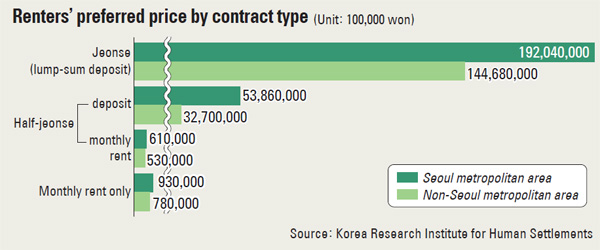Jump in jeonse turning renters into homeowners

Kim said he made his decision after the neighborhood’s jeonse price trend exceeded 80 percent of the apartment’s selling price. It turns out his 59-square-meter (635-square-foot) apartment sold for 210 million won ($193,000), while the jeonse was 180 million won.
In Korea, jeonse is a unique house rental system in which tenants pay a lump-sum to the property owner that will be returned, usually after two years.
Although house prices differ according to a variety of factors, a poll by the Korea Research Institute for Human Settlements showed that if the jeonse price is 77 percent or more of the property’s market price, people say they will consider buying.

Many see the research institute’s data as an accurate reflection of the market. But since it analyzed data only from big cities, the ratio of jeonse to retail price might be higher than that of nationwide surveys, such as the one released last month by Kookmin Bank.
According to the institute, home seekers look for 190 million won jeonse houses in the Seoul metropolitan area and 140 million won jeonse for the new cities in Gyeonggi.
The sought-after price for “half-jeonse,” which involves a smaller lump-sum deposit along with monthly rent, in the Seoul metropolitan area was 54 million won with monthly payments of 610,000 won, and 33 million won deposit with 530,000 won monthly in other areas.
For monthly rent housing, which doesn’t involve a lump sum deposit, the preferred price was 930,000 won per month in Seoul and 780,000 won in other regions.
The separate data from Kookmin Bank on last Thursday showed the average jeonse-to-retail price ratio for apartments was 70.2 percent in January, up 0.2 percentage points from a month earlier. The ratio was 52.3 percent in February 2009, but has been gradually rising since.
The research institute survey found that 15.4 percent of people looking for housing say they will buy if they can’t find the right house on jeonse, which is a slight increase from a year earlier. In fact, institute data showed that house sales in Seoul increased 32.5 percent year-on-year in 2014.
Still, jeonse remains the most-preferred housing arrangement for many Koreans. According to the institute report, 67.9 percent of those seeking housing in Seoul were looking for jeonse, followed by half-jeonse at 27.3 percent and monthly rent at 4.8 percent.
However, when it comes actually signing a contract, half-jeonse and monthly rent are increasing fast. Among contracts in the Seoul Metropolitan area in 2014, 47 percent were for half-jeonse and in other regions, the share was 58 percent.
Research institute data showed that among houses up for rent in the Seoul metropolitan area last year, only 41 percent were offered as jeonse, while more than half were half-jeonse. In other regions, only 33 percent of houses up for rent were offered as jeonse.
Also tipping the balance is the fact that house seekers are getting more sensitive to mortgage rates. The research institute survey showed that if potential renters found that a house owner’s mortgage exceeds 31.6 percent of the property’s retail price, they would not sign a jeonse contract because they would risk not getting their lump-sum deposit back if the owner fails to pay mortgage on time.
For those who live outside Seoul, the acceptable ratio of mortgage to house price was 27 percent, meaning they are more picky when selecting a jeonse.
As there seems to be a gap between the perception of supply and demand in housing market, experts said, this year is likely to be difficult for those seeking a place to live. They say the government should come up with a system to ease jeonse demand by promoting monthly rent of purchase, while at the same time alleviating pressure on monthly rent payers.
“House seekers prefer jeonse because they think of the lump sum deposit as a savings account, while monthly rent means the pressure of outgoing expenses every month,” said Park Chun-gyu, who leads the real estate market research center at the institute. “A large supply of public rental apartments, which have a contact system that includes both jeonse and monthly rent, could be a solution.”
BY CHOI YOUNG-JIN, JOO KYUNG-DON [kjoo@joongang.co.kr]










with the Korea JoongAng Daily
To write comments, please log in to one of the accounts.
Standards Board Policy (0/250자)